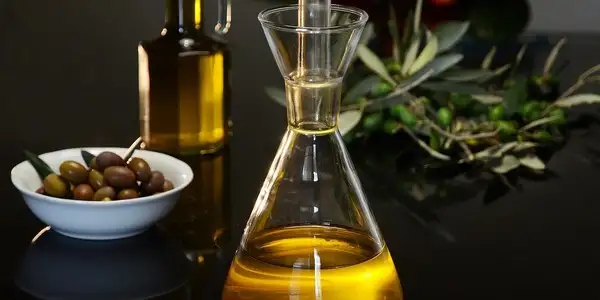
The question of whether olive oil is healthy comes to mind at the latest when you reach for a bottle of olive oil to cook with. Olive oil is, after all,...
Read more


|
Nutrient |
Per 100 g | Per portion (5 g) |
|---|---|---|
|
Calorific value |
577 kJ | 28.85 kJ |
|
Energy |
140 kcal | 7 kcal |
|
Carbohydrates |
1 g | 0.05 g |
|
Protein |
1 g | 0.05 g |
|
Fat |
13 g | 0.65 g |
The food Olives is composed of the following macronutrients.
Olives have a number of benefits as a food:
Olives are the fruit of the olive tree (Olea europaea), which is grown in Mediterranean countries and other warm climates. Olives are sold as green or black olives, depending on the degree of ripeness and processing. Green olives are usually processed immediately after harvest, while black olives are stored longer and have a milder flavor.
Olives and olive oil are an important part of the cuisine in many countries and are consumed both raw and processed. Olive oil is also commonly used as a cooking and salad oil.
However, it is important to know that olives and olive oil are high in calories and should therefore be consumed in moderation.
What is the shelf life of olives and how should they be stored?
Olives can be stored in the refrigerator for a few weeks. Olives preserved in oil will keep for about a year if kept in a cool, dark place. Pure olive oil should be stored in a cool, dark place and will keep for about 6 months.
How are olives grown?
Olives grow on olive trees that thrive in warm, dry climates like the Mediterranean. The trees can live up to a thousand years and bear fruit every year. The harvest time of olives depends on the variety and climate. In the Mediterranean region, harvesting usually begins in October or November, while in warmer regions the fruit can be harvested all year round.
What is the difference between green and black olives?
Green and black olives differ in ripeness and flavor. Green olives are picked before they are fully ripe and have a bitter, tart flavor. They are often pickled or marinated in oil to soften their flavor. Black olives, on the other hand, are harvested fully ripe and have a milder, nutty flavor. They are often used as a snack or to enhance dishes.
I love this app! The food is super varied and filling (and soo delicious!). With one purchase I have the ingredients for a whole week together, thanks to the shopping list. The ingredients are also readily available and not really expensive.
Nicole — App User
The first app in the field of nutrition tips that really convinces me. Updates get minor issues out of the way and new features are added all the time. Top!
Unknown user — App User
ave already tried many nutrition apps but here it is really great and you save a lot of time because you do not have to enter all the meals yourself! 👍👏
Mareen — App User
I don't usually rate apps but this one has to be rated.... I have never had such a great app just fits everything.... The nutrition plans are just absolutely awesome just everything is awesome many many thanks
Mareen — App User
This app is an excellent support for healthy eating even with little time and effort! Super recipes are also included. Highly recommended!
Lennert — App User